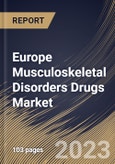Various factors, such as an aging population, sedentary behaviors, obesity, and a higher incidence of work-related injuries, contribute to the rise in incidences and prevalence of musculoskeletal disorders. Consequently, the increase in the number of cases of musculoskeletal disorders has raised the need for treatment options and supported the growth of the market. In addition, an increase in patient awareness regarding the significance of early diagnosis and treatment of MSDs drives the demand. Increased product launches by key participants are expected to impact market growth positively.
The need for musculoskeletal disorder drugs is not limited to developed countries; it is also observed in developing countries, which contributes to the expansion of the market share. In addition, a rise in promotional efforts by manufacturers is anticipated to accelerate the acceptance of such drugs in the near future. Also, the aging population is especially vulnerable to musculoskeletal disorders such as rheumatoid arthritis, osteoarthritis, and osteoporosis. The growing population of senior people has led to a growth in the need for medications to treat musculoskeletal disorders, which in turn has propelled the market for such medications forward.
An investigation conducted by the Ministry of Health in 2015 found that 64.5 percent of Italians over 11 have ingested alcohol at least once. Furthermore, there was additional proof of regular alcohol use between the ages of 11 and 24 that didn't involve meals. It is projected that as more people drink alcohol, adversely affecting numerous organ systems and tissues, including skeletal muscle, the prevalence of musculoskeletal problems will rise. Thus, the need for treatment drugs will rise, driving the market's growth in Europe.
The Germany market dominated the Europe Musculoskeletal Disorders Drugs Market by Country in 2022 and would continue to be a dominant market till 2029; thereby, achieving a market value of $7,381.3 Million by 2029. The UK market is experiencing a CAGR of 2.7% during (2023-2029). Additionally, The France market would exhibit a CAGR of 4.4% during (2023-2029).
Based on Distribution Channel, the market is segmented into Drug Stores & Retail Pharmacies, Hospital Pharmacies and Online Providers. Based on Route of Administration, the market is segmented into Parenteral and Oral. Based on Drug Type, the market is segmented into Analgesics, DMARDs, Corticosteroids and Others. Based on countries, the market is segmented into Germany, UK, France, Russia, Spain, Italy, and Rest of Europe.
The market research report covers the analysis of key stake holders of the market. Key companies profiled in the report include AbbVie, Inc., Amgen, Inc., Eli Lilly And Company, F. Hoffmann-La Roche Ltd., Johnson & Johnson, Merck & Co., Inc., Novartis AG, Pfizer, Inc., Teva Pharmaceutical Industries Ltd., and UCB S.A.
Scope of the Study
By Distribution Channel
- Drug Stores & Retail Pharmacies
- Hospital Pharmacies
- Online Providers
By Route of Administration
- Parenteral
- Oral
By Drug Type
- Analgesics
- DMARDs
- Corticosteroids
- Others
By Country
- Germany
- UK
- France
- Russia
- Spain
- Italy
- Rest of Europe
Key Market Players
List of Companies Profiled in the Report:
- AbbVie, Inc.
- Amgen, Inc.
- Eli Lilly And Company
- F. Hoffmann-La Roche Ltd.
- Johnson & Johnson
- Merck & Co., Inc.
- Novartis AG
- Pfizer, Inc.
- Teva Pharmaceutical Industries Ltd.
- UCB S.A.
Unique Offerings
- Exhaustive coverage
- The highest number of Market tables and figures
- Subscription-based model available
- Guaranteed best price
- Assured post sales research support with 10% customization free
Table of Contents
Companies Mentioned
- AbbVie, Inc.
- Amgen, Inc.
- Eli Lilly And Company
- F. Hoffmann-La Roche Ltd.
- Johnson & Johnson
- Merck & Co., Inc.
- Novartis AG
- Pfizer, Inc.
- Teva Pharmaceutical Industries Ltd.
- UCB S.A.








